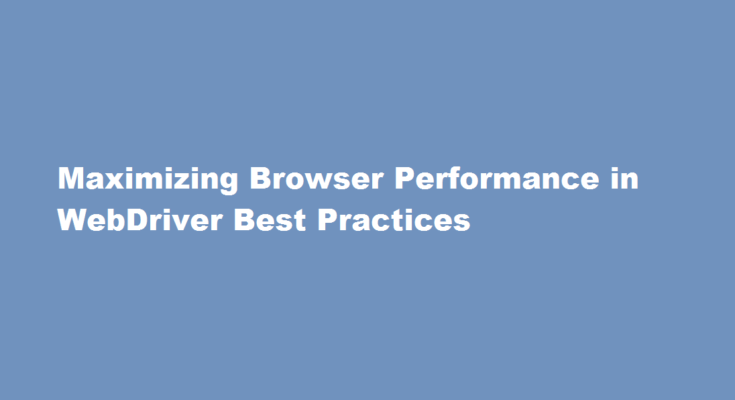Introduction
WebDriver is a powerful automation tool for web browsers, widely used in software testing and web scraping. To optimize the performance and efficiency of WebDriver, it’s essential to maximize the capabilities of the browser being controlled. In this article, we will explore some effective strategies and best practices to maximize the browser’s potential and enhance the overall WebDriver experience.
Choose the Right Browser
Selecting the appropriate browser can significantly impact WebDriver’s performance. Each browser has its strengths and weaknesses, so choose one that aligns with your requirements. Chrome, Firefox, and Safari are popular choices, each offering unique features and support. Consider factors such as compatibility, stability, and the availability of browser-specific extensions. Stay updated with the latest browser versions to leverage performance improvements and bug fixes.
Configure Browser Settings
Optimizing browser settings can enhance WebDriver’s efficiency. Disable unnecessary plugins, extensions, and add-ons that can consume memory and CPU resources. Clear cache and cookies before starting a WebDriver session to ensure a clean browsing environment. Adjust browser settings, such as network throttling, to simulate real-world network conditions for comprehensive testing. Enable hardware acceleration if available, as it can significantly boost rendering performance.
Utilize Headless Mode
Headless browsing allows WebDriver to operate without a graphical user interface, providing improved speed and efficiency. It reduces resource usage and eliminates the need for rendering graphics, resulting in faster execution times. Headless mode is particularly beneficial for automated testing and web scraping scenarios where visual output is not required. Ensure that the WebDriver framework and browser version support headless mode and make use of it whenever applicable.
Optimize Element Locators
Efficient element locators are crucial for maximizing WebDriver performance. Use CSS selectors over XPath whenever possible, as they tend to be faster and more concise. Restrict the scope of searches by providing specific parent elements or utilizing relative paths, reducing the search space and improving efficiency. Avoid using inefficient locators that traverse the entire DOM tree or depend on unstable attributes. Regularly review and update locators to adapt to changes in the application’s structure, minimizing maintenance overhead and improving script execution speed.
Manage Waits and Timeouts
WebDriver relies on waits and timeouts to synchronize with page elements during automation. Setting appropriate wait times is essential to balance performance and reliability. Use implicit waits judiciously, as they can introduce unnecessary delays. Prefer explicit waits that target specific elements, reducing the overall waiting time. Employ dynamic waits to handle asynchronous page updates effectively. Fine-tune timeout values based on network speed and application responsiveness. Regularly evaluate and optimize wait strategies to maintain a good balance between performance and stability.
FREQUENTLY ASKED QUESTIONS
How do I maximize and minimize my browser?
void maximize() – This method is used to maximize the current browser. You can customize the size of the browser according to the requirement of the scenario. Selenium webdriver does not provide any method for minimizing the browser, there is no such direct method. You need to use the resize method to minimize the browser.
Conclusion
Maximizing the browser’s potential in WebDriver is crucial to achieve optimal automation performance. By carefully choosing the right browser, configuring settings, utilizing headless mode, optimizing element locators, and managing waits and timeouts effectively, you can enhance WebDriver’s speed, stability, and efficiency. Regularly update your knowledge of browser-specific features and stay up-to-date with WebDriver and browser versions to leverage the latest improvements. Following these best practices will ensure a smooth and productive WebDriver experience, empowering you to build robust automated tests and efficient web scraping solutions.
Read Also : Streamlining App Downloads A Guide to Downloading Multiple Apps Simultaneously



